

Timeline
1924 Release of the first model: the MB1 175 with belt
1926 Creation of Motoconfort: Release of the 308
1929 Release of the first BMA (Bicyclette à Moteur Auxiliaire): "The B1"
1930 Release of the "B" block Creation of the 4 cylinders B5 & B7 (prototypes)
1934 Release of the S & R series: Arrival of Géo Ham who restyles the range
1945 Release of the D45, popular motorcycle par excellence
1946 Release of the "Z" series
1949 Creation by Charles Benoît & Eric Jaulmes of the Mobylette
1969 Release of the 125 two-stroke
1973 Release of the 350 and 500 three-cylinder
Sources: works by Patrick Barrabès et Eric Jaulmes
motobecane-club-de-france.fr
The 175 two-stroke 1923/1939
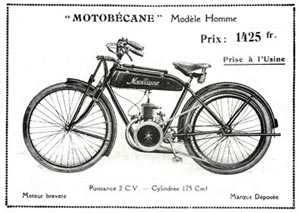
1923 MB1 Men's Model 175 cm3 2T
Unique model manufactured in Pantin in 1923. Its vocation is essentially utilitarian, although the advertising poster designed by Marcel Dupin represents it in a women's version, accompanied by a tennis player. The 1923 production is confidential, essentially consisting of prototypes. The actual start of production takes place at the end of 1924, the company's statutes having been officially filed on December 11, 1924.
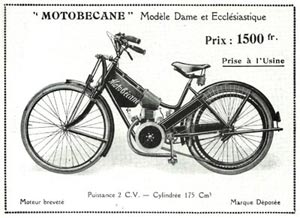
1923 MB1 Dame et Ecclesiastique Version 175 cm3 2T
This open frame version is offered to customers who wear a dress. A protective net prevents it from getting caught in the spokes. The nickel-plated steel grid above the cylinder prevents the driver from burning herself on the cylinder head. The sale price is ex-factory. This solution was common at a time when the agent network was still embryonic.

The very young brand is actively looking for agents in the provinces, as evidenced by this advertisement in "Cycles & Motocycles Industriels" dated October 28, 1923.
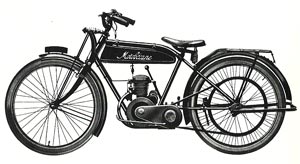
1925 MB2
175 cm3 2T
Belt drive
With two-speed gearbox and kick starter. This model is equipped with the famous "Wagons" footrests
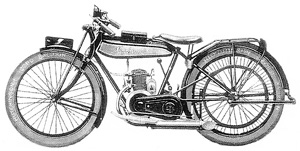
1927 Type D1
175 cm3 2T
175 cm3 2T
The D1 can be considered a basic model. It is the direct heir to the MB1. Its two-speed gearbox drives the rear wheel via a belt.

1928 Type D4
175 cm3 2T
Chain drive. Built using 250 type E chassis components.

1930 Type B2
175 cm3 2T
With saddle tank. Note the reduced braking on this model. No front brake, and two brakes on the pulley mounted on the rear wheel. One is controlled by foot pedal, the other by right hand lever.
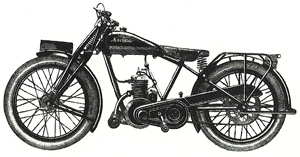
1931 Type B2A
175 cm3 2T
The exhaust is placed crosswise under the engine. A parallelogram fork and two drum brakes for the cycle part.
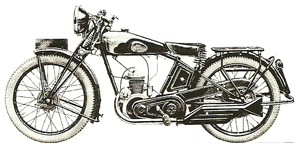
1937 Type B2A
175 cm3 2T
Appearance of the Novi magnetic flywheel. This does not provide lighting which is provided by an Alternovi in contact with the flywheel.

1939 Type B2A Sport
175 cm3 2T
The top of the 175 two-stroke range. This model has a 3 speed gearbox.
For more comfort: The 308 family 1926/1931
It was 1926 and the young Motobécane brand decided to create a larger displacement model to support the MB1 at dealerships. In order not to put off either the agents or the customers and to be sure not to compromise the very name of Motobécane, a new brand was found, which would be the Motoconfort
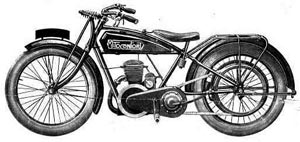
1926 308 MC1
308 cm3 2T
The cycle part, comfortably seated on two large balloon tires (700x80), is suspended at the front by a pendulum fork based on the principle of that of the MB1. Braking is provided by two single-pad brakes, both acting on the rear wheel. The main one, actuated by the right heel, acts on the transmission pulley while the second controlled by the right hand acts on a rim pulley located on the other side of the wheel. This model will be manufactured in 1927 without any evolution.
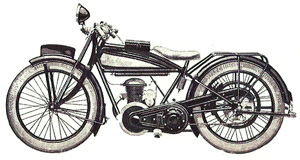
1928 308 Type F
308 cm3 2T
The 2 speed gearbox is retained but it has secondary transmission by chain. Given the removal of the rim pulley, the two brake pads exert their pressure on the right pulley. The pedal also changes sides.
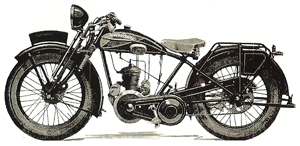
1929 308 Type F4 / MC7 at Motoconfort
308 cm3 2T
Aesthetic upheaval with the abandonment of the inter-tube tank in favour of a very "Art Deco" saddle tank. New "Druid" type fork. The braking pulley disappears and leaves room for two drum brakes. The toolbox is placed on the side of the luggage rack. The electric lighting is now fitted as standard and activated by simply tilting the "Alternovi" on the flywheel.
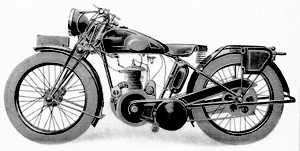
1930 308 Type F5 / MC8
308 cm3 2T
Final evolution with the assembly of the parallelogram fork and central spring as well as the reservoir of the B blocks.
The compromise: The 250 Type E 1927/1932
Produced for a relatively short period of time, these 250 cm3 Type E at Motobécane and MC6 at Motoconfort, represented a fair compromise between the 175 and the big 308, the top of the range of Pantin's production before the appearance of 4-stroke engine models.
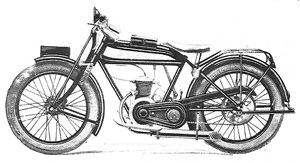
1927 250 Type E / MC6
250 cm3 2T
Strictly identical to the 175 D4 / MC2B, the E-type can be distinguished at first glance by its magneto inclined towards the rear and the six nuts which hold the cylinder head.

1928 250 Type E
250 cm3 2T
Very little evolution on this model. The initial seat in stamped sheet metal covered with felt and leather is now replaced by a saddle with a leatherette top mounted on sheet springs. The optional installation of a large diameter headlight fixed on the fork and a small red light, powered by a Novi set (sold separately)
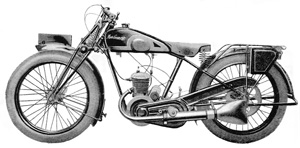
1930 250 Type E
250 cm3 2T
Complete overhaul of the model with the appearance of a new cycle part. Assembly of a parallelogram fork and central spring as well as a saddle tank. The gear lever moves to the right side of the tank, allowing more precise handling than the long lever coming directly out of the box.

1934 250 B3A
250 cm3 2T
The unknown of the 250 range. Two years after the official end of production, the 250 resurfaced slightly modified with contemporary cycle part elements and especially equipped with a flywheel ignition. This motorcycle will not appear in any catalog but will nevertheless be released in a very limited series.
BLACKBURNE 4-STROKE ENGINE MODEL 1927/1930

1927 350 Type G
350 cm3 4T
The first generation was equipped with a frame with a tank between tubes. The cycle parts had a "DRUID" type fork, drum brakes, 27 x 4 bead tires, 160 mm flat mudguards, a luggage rack, a TERRY or PLANOR saddle, knee grips and a 2.5l oil tank and were not equipped with lighting as standard.

1928 350 Type G
350 cm3 4T
The second generation released in 1928 received a new frame with saddle tank and a different oil tank but still of the same capacity. The rest of the cycle part has the same equipment, the only changes will be on the accessories (lighting, toolbox, license plate) and this until the end of production (1930).

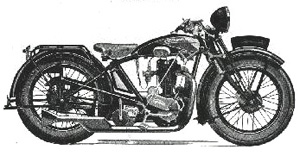
1929 500 Type H
500 cm3 4T
1929 350 Type K
350 cm3 4T
It was not until 1929 that the rocker arm models arrived. But the MOTOBECANE management did not consider it necessary to give them a type and the catalogue simply states that they are the same models with a more powerful engine.
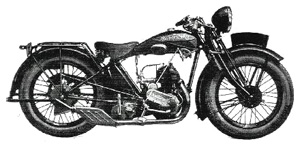
1929 500 Type L
500 cm3 4T
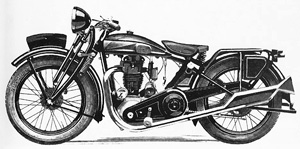
1930 500 Type H2
500 cm3 4T
The H2 or L2 Amateur Competition type with dual exhaust engine with high compression piston, racing cam, IVG Novi magneto, AMAC type 6 carburetor and running on petrol and benzol which allowed this 28.5 hp motorcycle to achieve speeds of 130 to 140 km/h.
250 JAP ENGINE 4 STROKE 1928
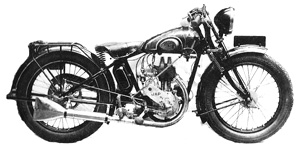
1928 250 Type R2
250 cm3 4T
Motobécane did not have a 250cc 4-stroke engine of its own brand at the time, any more than at Blackburne, the R2 would use the JAP engine.
Single cylinder 4-stroke. Side valves. Single exhaust.
LES BLOCKS B MOTOBECANE 4 Stroke 1930/1939
The "B" block model engine is the first 4-stroke engine manufactured by Motobécane. Available in several displacements, from 175 to 500cc, with side valves, overhead valves or even 4 valves for the extremely rare 500 B5C GS. The box is integrated into the block, this configuration is particularly modern for a time when the separate box is still the norm.
The "B blocks" (or T at Motoconfort)
B2s - B22 (175 cc)
B33 (212 cc)
B23 (222 cc)
B3 (250 cc)
B33a (250 cc à soupapes latérales)
B33c (250cc culbuté)
B3l (250 cc à soupapes latérales)
B3c (250 cc culbutés) - B3cs (250 cc culbutés "sport")
B34 (326 cc à soupapes latérales)
B4 (350 cc) - B4l (350 cc à soupapes latérales)
B4c (350 cc culbutés) - B4cs ("sport") - B4cgs ("Grand sport")
B44 (350 cc à soupapes latérales) - B44l (350 cc à soupapes latérales)
B44 st
B44c (350 cc culbuté) - B44cl - B44c st (350 cc culbuté standard)
B44l
B5 (500cc) - B5l
B5c - B5cs - B5 cgs
B55 - B55c
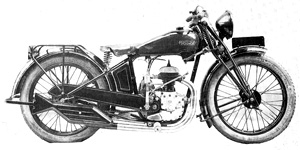
1931 175 Type B2S
175 cm3 4T SV
On this budget model, the chrome plating is limited to the gearshift lever, the kickstarter and the exhaust system.

1930 250 Type B3
250 cm3 4T Sidevalve
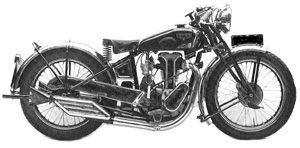
1930 250 Type B3C Sport
250 cm3 4T OHV
The "Sport" designation implied a rear kickstand handle and more extensive chrome plating. The rocker arms were enclosed and the handlebar levers were again reversed.
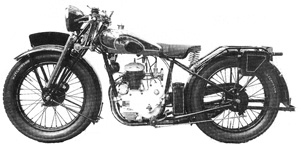
1930 350 Type B4
350 cm3 4T SV
Presentation at the 1930 Motor Salon of the B4 model, with 350 cm3 3-speed B block; here in the "luxury" version with NOVI electric lighting.
An article on Motobécane types B3C and B4C appeared in Moto Revue on July 25, 1931.
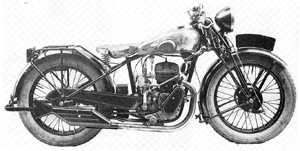
1931 500 Type B5
500 cm3 4T Sidevalve
The right side of the B5 shows the under-housing belt drive of the three-brush Novi 6-volt dynamo.
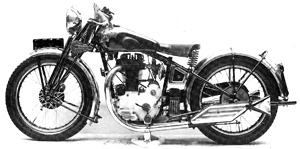
1932 500 Type B5CS
500 cm3 4T OHV
The 500 type B5C Grand sport is the famous 4-valve with dual exhausts which won two races in its category at the Bol d'Or in 1932 and 1933 as well as the ISDT in 1932.
The B5 (T5) 500 cc and the B7 (T7) 750 cc 1929/1930
3 exceptional prototypes, 4 cylinders (500 with side valves and 750 "overhead" with overhead camshaft) presented in the 1930 catalogue and at the Paris Motor Show the same year.
1929 500 Type T5
500 cm3 4T Sidevalve
TYPE B5. - BLOC MOTEUR. — 4 Cylindres. - Alésage 46. — Course 75.
Transmission par arbre et couple conique. — 3 Vitesses. — Pneus de 27X4. - Réservoir nickel, éclairage et allumage par dynamo et accumulateurs, avertisseur.
TYPE B5. - ENGINE BLOCK. — 4 Cylinders. - Bore 46. — Stroke 75.
Transmission by shaft and bevel gear. — 3 Speeds. — 27X4 tyres. - Nickel tank, lighting and ignition by dynamo and accumulators, horn.
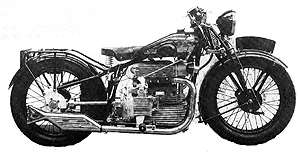
1930 750 Type B7
750 cm3 4T OHV
Presented at the October 1930 Motor Show, the B7 is a 750 with an overhead camshaft controlled by a vertical shaft, visible at the front of the engine.
THE R and S BLOCKS 1933/1947
The "R" block is the first version of the "S" block.
The "R blocks" (or "C" at Motoconfort)
R23
R3c - R33a (250 cc)
R34 (350 cc à soupapes laterales)
R4 - R4c - R44 - R44c (350cc)
R5 - R5c - R55 - R55c (500cc)
"S" blocks (or M at Motoconfort)
S3c (250cc)
S4 - S4c - S4cgs (350cc)
S5 - S5c - S5cgs (500cc)

1933 350 Type R4C
350 cm3 4T OHV
The 1934 R4C 350 single exhaust was catalogued with 3 manual gears. The design of the exhaust caused much ink to flow, but was much copied.
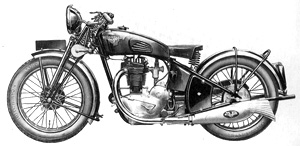
1934 500 Type S5C GS
500 cm3 4T OHV
The very beautiful and very rare 500 "Grand Sport" with "S" block and four valves was only produced in 1934 and 1935. It is called "M5C GS" at Motoconfort and "S5C GS" at Motobecane.
Its cylinder head is that of the "B Grand Sport" engines. Both motorcycles do not yet benefit from the 4-speed gearbox, but are equipped with the foot selector mounted at the front of the block.
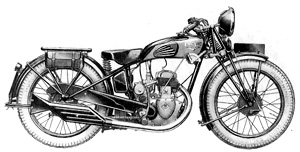
1934 250 Type C3
250 cm3 4T Sidevalve
The Motoconfort type C3: the "S" block also existed with side valves. The "C" presentation was less luxurious: note the sheet metal silencer.
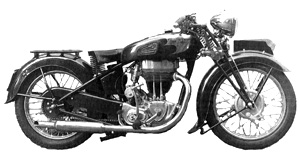
1938 500 Type "Grand Sport Superculasse"
500 cm3 4T OHV
Last model before the war, final descendant of the 300,000 machines built since production began.
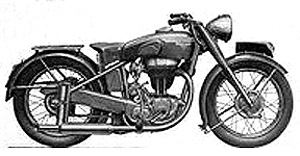
1947 350 Type R46c
350 cm3 4T OHV
The S blocks have disappeared from the catalog, with the exception of this magnificent machine adopting the standards of the time, a sliding rear suspension, telescopic fork, 4-speed gearbox, and the "brown/beige" colors of the Z2c. The whole is imposing and of beautiful workmanship, but will only know a confidential diffusion, the period of "vache maigre" and reconstruction not being favorable to medium cylinders, the less fortunate customer will prefer ... The very sober D45, or the Z2c
The D45 1945/1960
The queen of the popular. Who doesn't know the legendary D45! The 125 Motobécane with side valves was inseparable from the national road network for almost two decades.
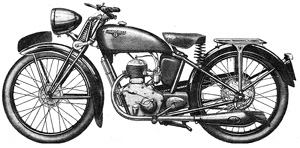
1945 D45A
125 cm3 Sidevalve
The D45 appeared in 1945 under the name D45A, had a parallelogram fork and a rigid rear end. Six to seven months of delay were necessary to obtain one.
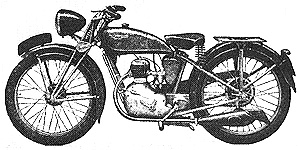
1947 D45B
125 cm3 Sidevalve
At the threshold of 1948. The crankshaft is modified, as well as the engine crankcase, increasing the oil capacity from 0.75L to 1.25L.
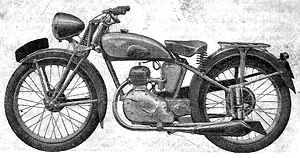
1949 D45S
125 cm3 Sidevalve
In 1949, a major modernization took place with the adoption of plunger rear suspension. The D45 becomes D45S (for suspension). The four centimeters of travel are certainly very small, but they still allow to correctly filter the jolts due to the paving of the streets and to improve the road holding.
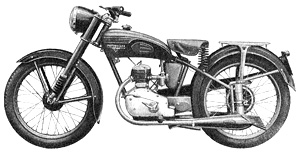
In 1951, a telescopic fork was added to further improve handling. This would be effectively the last major development on this model, which retained its dual clutch control and three manual gears.
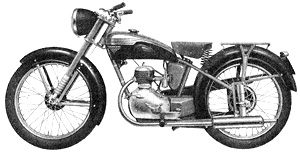
1956 D45S LUXE
125 cm3 Sidevalve
This "luxury" version has a tank, rims and a round chrome exhaust as well as deep mudguards. The popular lightweight will continue an exemplary career until early in 1961.
This page is adapted from an archive of a site by Patrick Barrabès. Further information under French Resources